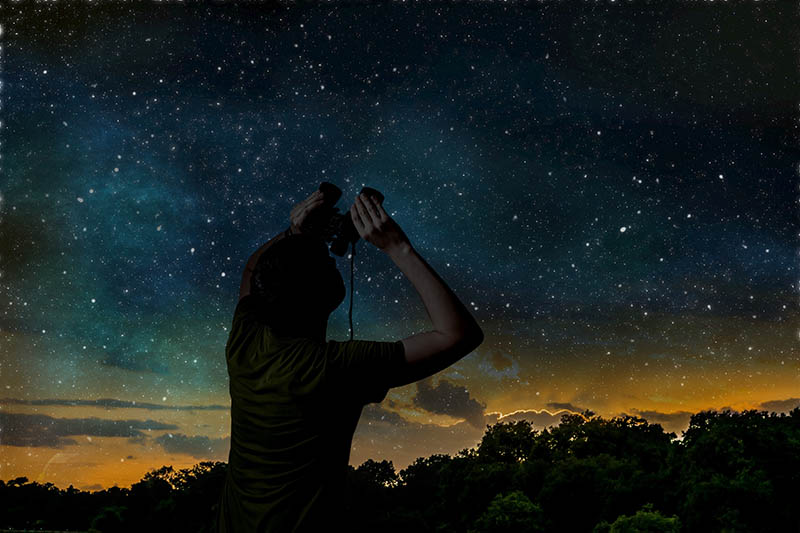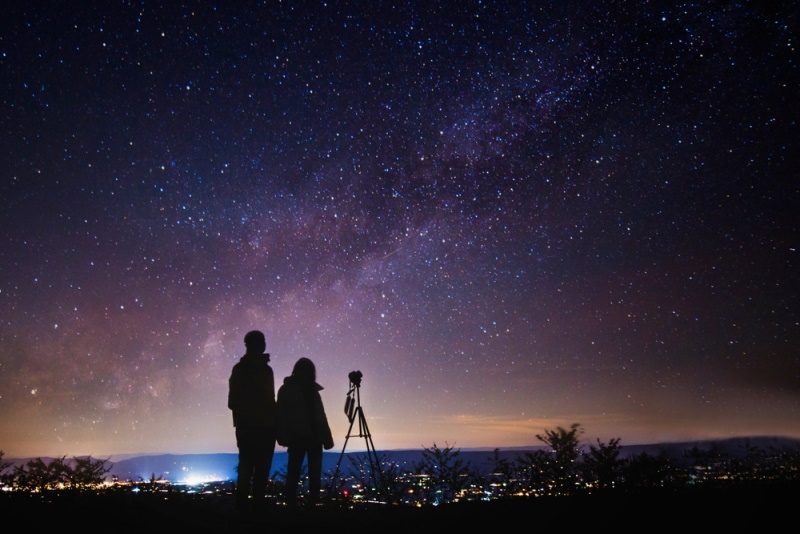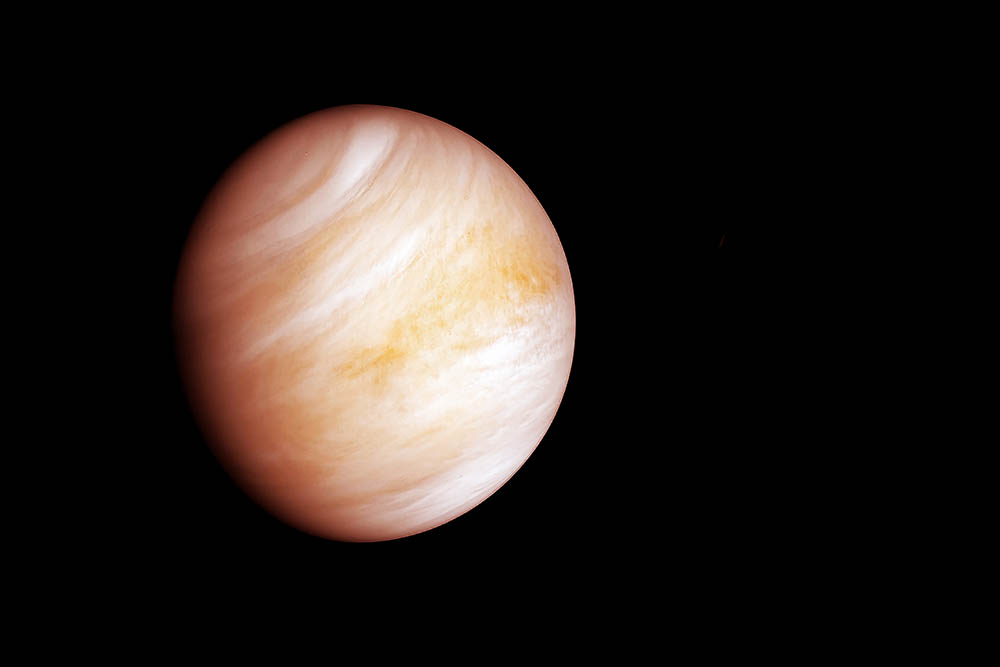Can You Use Binoculars to Look At Stars? How to Choose the Right Pair
Last Updated on

A crystal-clear evening sky can bring out the wonder-filled stargazer in all of us. When the moon is bright and an endless sea of stars spans the sky on a quiet night, it isn’t easy to resist the urge for a deeper look. You don’t need a telescope to enhance the experience. With a decent set of binoculars, you can take a deeper look at the moon and stars to gain a new perspective on the universe around us!
Click to Skip Ahead:
- Can You Use Binoculars to Look at Stars?
- What Can I View with Binoculars?
- Choosing Binoculars for Star-Gazing
- Which Binoculars Are the Best for Looking at the Stars?
- Other Crucial Specs to Consider
- How to Use Binoculars to View Stars

Can You Use Binoculars to Look at Stars?
Binoculars are a great way to get more out of your star-viewing sessions. Space has depth. While a telescope will allow you to catch glimpses of far-off and often imperceptible bodies, binoculars add clarity and detail to significant objects in our galaxy.
As a star-gazing starting point, binoculars are hard to beat. They’re cheaper than telescopes and easier to use. You can take them almost anywhere without any setup involved, and their low magnification provides a steadier view and simpler time locating areas of interest. Even with a high-powered telescope, you may still use your binoculars more often.


What Can I View with Binoculars?
The moon is one of the easiest and most satisfying targets for binocular viewing, giving you a refreshing look at the details dotting its surface. A waxing crescent will appear a couple of days following the new moon. You can then follow the moon along its changing phases throughout the month.
Aim your binoculars at the terminator where the moon’s light and shadowed sides meet. As the month progresses and the terminator moves, the sun’s light will cast shadows across a shifting array of valleys, mountains, and craters.
Past the moon, you can catch closer glimpses of planets, constellations, nebulae, and deeper features of the galaxy. Sky-charting apps for your smartphone, such as Star Walk and SkySafari, allow you to plan your viewing and learn more about everything you see.
Planets

The planets often disappear amidst the blanket of stars when we view them with the naked eye. With a quality set of binoculars and a steady hand, you can bring more definition to Jupiter and Saturn, while Mercury and Venus’s phase changes will barely come into view.
Jupiter’s four moons can come into view alongside the solar system’s largest planet, and Saturn transforms from a dot to an oblong form as its rings begin to add shape. To get the most clarity and the ability to discern all of Jupiter’s moons and possibly Titan, Saturn’s largest moon, you’ll need a higher power and aperture of over 60mm. At that stage, night-viewing binoculars gain significant heft and are challenging to hold steady, necessitating a tripod.
Constellations, Galaxies, & Nebulae

Binoculars will give you a closer look at constellations, double stars, star clusters, and views of the Milky Way and beyond. Some of the notable sights you can enjoy through a quality set of binoculars include:
- M13: a globular star cluster in the constellation Hercules
- Omega Centauri: a star cluster that comes into better view through binoculars or a telescope
- Large and Small Magellanic Clouds: dwarf galaxies viewable from southern locales
- Andromeda Galaxy (M31): the closest large galaxy to the Milky Way
- Pleiades (M45): an open star cluster known as the Seven Sisters
- Triangulum Galaxy (M33): a smaller galaxy just past Andromeda
- Mizar and Alcor: a double star in Ursa Major
- The Orion Nebula: the middle star of the hunter’s sword

Choosing Binoculars for Star-Gazing
There are several individual specs to consider when getting an appropriate set of star-gazing binoculars, as the viewing conditions are much different than during the day. The most apparent specs appear on the binoculars as two numbers, like 10×50 or 7×35.
The first number is the magnification power. Easily enough, it’s how many times the binoculars will magnify an object. A high number will mean a closer look, but that doesn’t mean higher is always better. Greater magnification means more shakiness while viewing. More importantly, it also means images are dimmer, which you certainly don’t want with an already darkened view.
While magnification is essential, the aperture and exit pupil size are more crucial considerations for looking at stars with binoculars.

Aperture
The aperture is the size of the objective lens, the large glass lens at the front of the binoculars through which light enters. In binocular specs, the second number denotes the aperture in millimeters. For instance, a set of 10×50 binoculars has an objective lens with a 10X magnification power and a diameter of 50 mm.
A decent aperture is essential because it determines how much light enters the binoculars, ensuring a crisper image. The ideal size is around 40–50 mm. As you increase the size of the lenses, you will have more weight to manage, and the instability may require a tripod.
Exit Pupil
The exit pupil is a small hole where light exits the binoculars just before it reaches your eye. You can find the size of the exit pupil by dividing the aperture by the power. For example, in a 10×50 set of binoculars, the exit pupil is 5 mm, while the exit pupil for a 7×42 is 6 mm. With a larger exit pupil, more light hits your eye at once.
The ideal exit pupil size should be slightly smaller than the size of your pupil. If the pupil size is too large, some light can’t enter your eye, making it go to waste and forcing you to move your eyes. If it’s too small, you won’t be using all of your pupils to take in the light coming to you, and the image will appear darker.
The exit pupil size for nighttime use is slightly larger than for daytime viewing. At night, our pupils widen to take in more light, meaning the exit pupil size to match it will also widen. While a 2–3 mm exit pupil is perfect for most people during the day, you’ll want an exit pupil of around 5 mm or slightly higher for your nighttime eyes.


Which Binoculars Are the Best for Looking at the Stars?
Considering the effect of the aperture, magnification, and exit pupil at night, 10×50 binoculars are an excellent set for star viewing. You can lower the power as far as 7 and get decent clarity from far-off points in the sky while making the binoculars lighter and easier to hold steady.
Anything larger than 10×50 will enhance the view even more and offer optimal viewing as long as you stay around the 5–6 mm exit pupil size, but you will likely need a tripod to keep it steady. Always test binoculars before buying to see how they feel in your hands and against your eyes.
Other Crucial Specs to Consider
While sizing is crucial for comfort and performance, it isn’t the only criterion to consider for the best possible experience. Although they often add to the price, consider the following specs before buying your star-gazing set:
- Lens coating: Coatings prevent light reflection and loss when it hits the lenses (multi-coated provide the brightest, clearest images)
- Focusing: Center-focusing binoculars adjust both left and right sides simultaneously, while individual focusing lets you adjust each eye separately
- Eye relief: Better eye relief means your eyes can be further from the eyepiece while viewing the image, a critical consideration for those with glasses
- Image stabilization: Reduces shake for better viewing
You don’t need to pay extra for weatherproof models if you’re only buying binoculars to view stars. Rain and bright, starry nights rarely go hand-in-hand, so you likely won’t benefit from it.


How to Use Binoculars to View Stars
Avoiding light pollution is crucial in getting the best look at the stars. A rural area away from a city’s artificial lighting on a moonless night will ensure they are the brightest points in the sky. Clear, cold nights often offer the best atmospheric conditions for viewing as there is less moisture in the air to block your view.
Finding objects in the sky with binoculars and holding them steady in your sight isn’t easy. Here are a few tips for getting the best view without getting frustrated in the process:
- Use a tripod for steady, hands-free viewing
- Get a chair, a blanket to lie on, or a wall to lean against to stay comfortable and keep your hand steady
- Find the point you wish to view with your naked eye and bring your binoculars to your eyes to avoid searching for your target
- Use bright stars to help you target nearby objects
- Hold the binoculars close to the objective lenses rather than near the eyepiece

Conclusion
Binoculars are an essential tool for serious stargazers. They can make an excellent precursor for using the telescope or, in many cases, provide the best views of our galaxy. Follow these tips, pull out a star chart, and discover how a quality set of binoculars can improve your stargazing.
Featured Image Credit: vchal, Shutterstock
Table of Contents
About the Author Robert Sparks
Robert’s obsession with all things optical started early in life, when his optician father would bring home prototypes for Robert to play with. Nowadays, Robert is dedicated to helping others find the right optics for their needs. His hobbies include astronomy, astrophysics, and model building. Originally from Newark, NJ, he resides in Santa Fe, New Mexico, where the nighttime skies are filled with glittering stars.
Related Articles:
How to Collimate Binoculars: 9 Expert Tips
How to Choose Binoculars for Bird Watching: 10 Expert Tips
Binocular Magnification Chart: Numbers & Distances Compared
What Is the Best Binocular Magnification for Hunting? Optical Features Explained
When Were Binoculars Invented? History, Today & Future
What Does 20X50 Mean on Binoculars? Our Helpful Guide
10 Best Binoculars in Canada of 2024: Reviews & Top Picks
Infrared Binoculars vs. Night Vision: Which Should I Choose?
